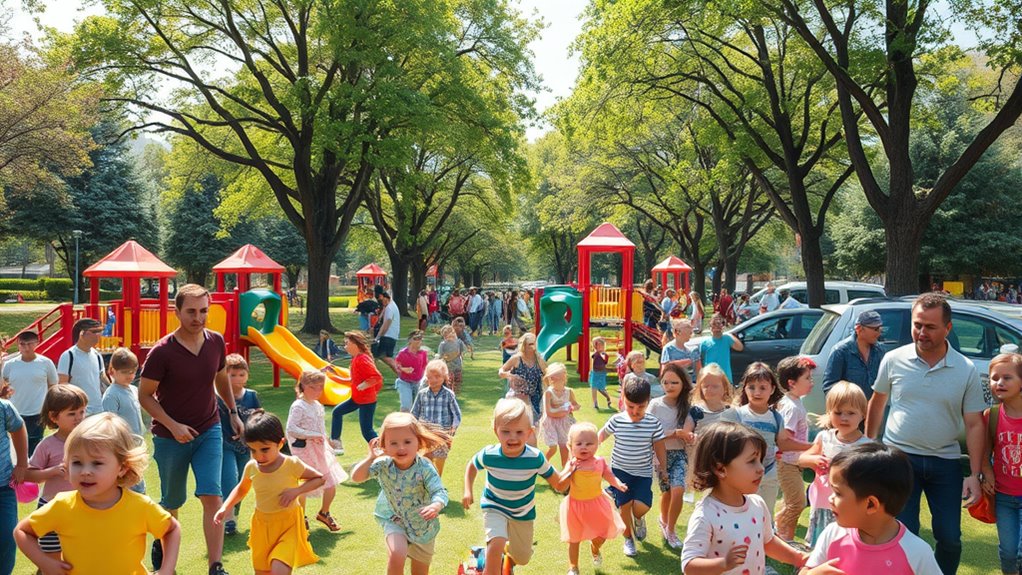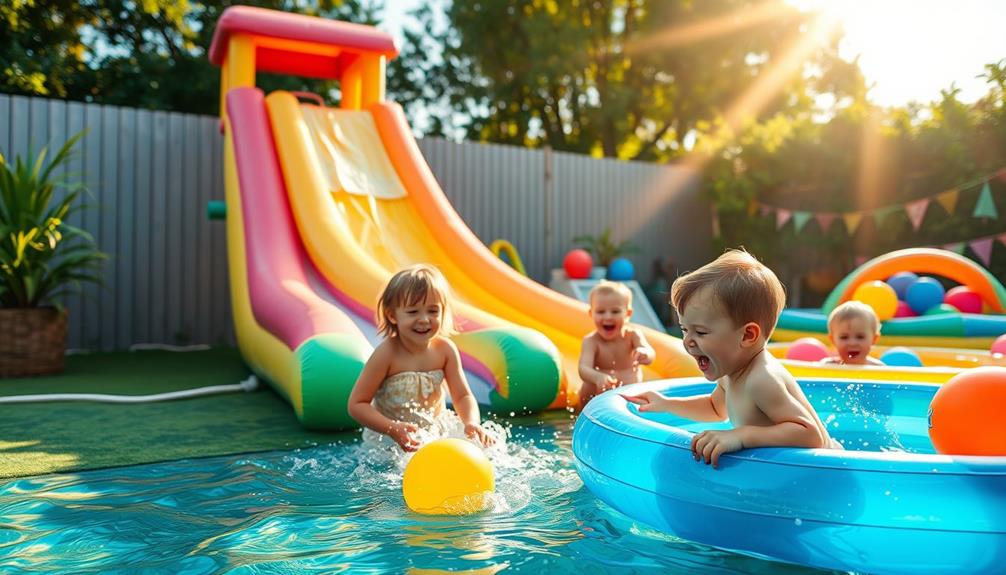To keep kids safe in crowded parks, plan ahead by reviewing the layout, establishing safety rules, and packing essentials. Use bright clothing, wristbands, or color-coded identifiers to easily spot your child, and constantly supervise by staying close and maintaining visual contact. Set clear boundaries and practice safety drills. If someone gets lost, stay calm, notify staff, and head to a pre-agreed meeting point. Continuing will provide you with even more effective tips to handle chaotic situations confidently.
Key Takeaways
- Establish clear safety rules and conduct safety drills to prepare children for potential chaos.
- Use bright clothing, wristbands, or visual identifiers for quick supervision and easy child identification.
- Maintain constant visual contact, set physical boundaries, and stay vigilant to prevent wandering.
- Pre-arrange designated meeting points and have emergency protocols ready for child separation scenarios.
- Pack essentials like water, snacks, and a first aid kit, and review emergency procedures for crowd management.
Preparing Before You Visit the Park

Before heading to a crowded park, it’s important to plan ahead to guarantee your safety. Check the park’s amenities beforehand—know where the restrooms, exits, and shaded areas are. This helps you stay organized and reduces stress during your visit. If you’re planning group play, coordinate with other parents or guardians about meeting points and supervision strategies. Bringing essentials like water, snacks, and a first aid kit ensures you’re prepared for any situation. Familiarize yourself with the park’s layout so you can quickly navigate crowded spaces and identify safe spots. Knowing the available amenities and how to access them keeps everyone comfortable and reduces chaos. Being aware of emergency procedures can be crucial in case of unexpected incidents. Proper preparation allows you to enjoy the park without unnecessary worries about safety or logistics. Additionally, understanding crowd management strategies can help you better handle large groups and prevent potential accidents. Recognizing the importance of visual supervision can further enhance your ability to keep children safe in busy environments. Being mindful of nutritional needs when packing snacks can help maintain energy levels and prevent tantrums. Incorporating mindful planning techniques can also help reduce stress and improve overall experience during your park visit.
Establishing Safety Rules With Your Kids

You should set clear safety expectations with your kids before heading to the park so everyone knows what to do. Practice safety drills together to help them respond confidently in different situations. Using visual cues, like signs or color codes, can make these rules easier for your kids to remember and follow. Incorporating safety education into your preparations can further reinforce their understanding and readiness. Additionally, establishing clear guidelines about appropriate behavior helps in minimizing chaos and ensures a safer environment for all children. Emphasizing consistent rules can also aid children in understanding boundaries and expectations during outdoor play.
Set Clear Expectations
Setting clear expectations is essential for keeping kids safe in crowded parks. When you communicate safety rules upfront, your child understands what’s expected and can act accordingly. Establish simple guidelines such as staying close, not talking to strangers, and alerting you if they get separated. Use clear language and reinforce these rules regularly. Remember, effective parental supervision depends on your ability to set boundaries and maintain crowd awareness. A new sentence with child supervision strategies and the rest of the sentence. Remind your child that they should always stay within sight and follow instructions if they get lost. Creating a shared understanding helps prevent accidents and confusion. Keep your expectations consistent and adaptable to the situation, ensuring your child knows how to behave safely amidst the chaos of a crowded park. Incorporating visual cues or signals can also help reinforce safety procedures effectively. Additionally, understanding industry trends in child supervision can provide new strategies to enhance your approach. For example, utilizing technology-based tools can offer additional safety measures in busy environments.
Practice Safety Drills
Practicing safety drills with your kids helps reinforce the rules you’ve set and prepares them to respond calmly in real situations. During drills, focus on distraction management by teaching your kids to stay alert and recognize potential hazards, even when they’re distracted by peers or surroundings. Role-play scenarios where they may need to find you quickly or stay close when the park gets crowded. Encourage them to practice peer interaction skills, like politely alerting others if they notice a problem. Repeating these drills builds confidence and reduces panic if an actual emergency occurs. Keep the sessions short and engaging, emphasizing calm, clear actions. Over time, your kids will become more comfortable following safety rules amidst the chaos of a crowded park.
Use Visual Cues
Visual cues are powerful tools that help children understand and remember safety rules in busy park environments. They reduce visual distraction and aid noise management by providing clear, simple signals. Use brightly colored signs or symbols to indicate boundaries, such as a line for safe zones or crossing areas. Visual cues like wristbands or flags can identify kids who need extra supervision. Incorporate pictures showing safe behavior, like holding hands or staying within sight. These cues reinforce rules without overwhelming your child with verbal instructions amid noise and chaos. When kids see familiar symbols, they’re more likely to follow safety guidelines. Consistent use of visual cues creates a visual language that keeps everyone safer, even when the park is crowded and noisy. Utilizing tuning techniques can also help in customizing safety signals to better suit your child’s specific needs, especially by aligning them with established safety standards and best practices. Additionally, understanding vetted safety tools ensures the methods you implement are reliable and effective. Incorporating behavioral cues can further enhance compliance by clearly indicating expected actions and promoting positive habits.
Using Visual Cues and Identifiers to Keep Track

When you’re in a crowded park, using visual cues and safety identifiers can make it easier to keep track of children or friends. Bright clothing, such as hats or shirts with bold patterns, helps you spot them quickly. Consider using colorful wristbands or lanyards with your contact info, so others can help if needed. Unique accessories, like themed hats or backpacks, also serve as visual cues, making your child stand out in a sea of people. These identifiers aren’t just for quick recognition—they provide immediate safety signals, reassuring you that your kid is easy to identify. Incorporating Kia Tuning options such as custom accessories or themed gear can further enhance visibility. Additionally, using visual cues that are easily distinguishable can help prevent confusion in busy settings. Implementing protective styling techniques with your child’s accessories can also increase their durability and safety. The use of personalized identifiers can also foster a sense of ownership and familiarity, making children more comfortable and aware of safety measures. To improve overall safety, choosing identifiers that are durable and waterproof ensures they remain visible even in changing weather conditions. By doing so, you reduce the risk of losing track of loved ones amidst the chaos, ensuring everyone stays safe and easy to find.
Staying Vigilant and Monitoring Your Child Constantly

You need to keep a close eye on your child at all times, especially in crowded areas. Using visual markers like bright clothing or unique accessories helps you spot them quickly. Setting clear safety boundaries guarantees your child stays within a safe zone and reduces the risk of wandering off. Incorporating electric bikes or other mobility devices can also help you navigate large crowds more efficiently and keep pace with your child. Additionally, integrating AI-powered monitoring tools can provide real-time alerts if your child leaves a designated safe zone, offering an extra layer of security. Considering tuning techniques for your vehicle can improve your ability to respond quickly in busy environments, ensuring safety and mobility.
Keep Eyes on Child
Keeping a constant eye on your child is essential in crowded parks to prevent accidents or getting separated. Use supervision strategies like staying close, holding hands, or using a harness if needed. Be alert and avoid distractions; put away phones or other devices to focus fully on your child. Consider distraction techniques, such as engaging them with a game or conversation, to keep their attention on you. Remember to:
- Maintain visual contact at all times
- Use verbal cues to keep them alert
- Keep your child within arm’s reach
- Regularly scan the environment for potential hazards
Use Visual Markers
Have you ever thought about how visual markers can help you stay alert in a crowded park? Using visual markers like brightly colored scarves, hats, or wristbands makes it easier to spot your child amid the chaos. Safety signs placed around the area can also serve as quick reference points for emergency procedures or meeting spots. These visual cues act as constant reminders to keep your child in sight and reinforce your vigilance. Make sure markers are distinct and easy to recognize from a distance, so you can quickly identify your child or alert others if needed. By leveraging visual markers and safety signs, you create a visual system that helps you monitor your child more effectively and stay aware of their location at all times.
Establish Safety Boundaries
While it’s tempting to relax your vigilance in a busy park, establishing clear safety boundaries is essential for keeping your child safe. Consistent boundary enforcement helps your child understand limits and stay within safe zones. To do this effectively:
- Keep your child within sight at all times
- Use physical markers like ropes or natural barriers
- Set clear rules about staying close and not wandering
- Remind your child of boundaries regularly
Child supervision should be ongoing, and boundaries need reinforcement if your child tests limits. By actively monitoring and enforcing these boundaries, you reduce the risk of accidents or wandering off. Remember, staying vigilant and clear about these safety boundaries is your best defense in a chaotic environment.
Navigating Crowds and Managing Your Child’s Movements

Managing crowded parks can be overwhelming, but staying alert and proactive helps keep your child safe. Understanding crowd psychology helps you anticipate how others might behave, so you can better guide your child’s movements. Child impulsivity can lead to sudden darting or wandering, especially in busy environments. To manage this, hold their hand or use a wristband with contact info. Keep a close eye on their actions, and establish clear boundaries beforehand. Remind your child to stay close and avoid distractions, like toys or snacks, that might tempt them to stray. Staying calm and assertive helps you communicate effectively and maintain control. By understanding group dynamics and your child’s tendencies, you can navigate crowds confidently while minimizing risks.
Emergency Protocols and What to Do if Someone Gets Lost

Knowing exactly what to do if your child gets lost in a crowded park can make all the difference in ensuring their safety. Stay calm and follow established lost child procedures, which include immediately notifying park staff and using emergency communication systems. Clearly describe your child’s appearance and last known location. Gather helpful details like clothing and any distinguishing features.
Stay calm, notify staff immediately, and clearly describe your child’s appearance and location.
Remember to:
- Find a safe, visible spot to wait if you’re separated.
- Designate a specific meeting point in advance.
- Use park staff or security to help broadcast your child’s description.
- Never chase after your child; instead, focus on communication and staying visible.
Quick, calm action combined with clear emergency communication can help reunite you swiftly and keep everyone safe.
Frequently Asked Questions
How Can I Prepare My Child Emotionally for Crowded Environments?
To prepare your child emotionally for crowded environments, focus on building their emotional resilience and addressing crowd anxiety. Talk openly about what to expect and practice calming techniques like deep breathing. Role-play scenarios to boost confidence and help them manage feelings of overwhelm. Reinforce positive experiences, so they feel secure. Over time, your child will become more adaptable, handling crowded situations with greater ease and confidence.
What Are the Best Age-Appropriate Safety Tools for Kids in Crowds?
Imagine your child wielding a tiny superhero badge—child identification that screams, “Hey, I’m over here!” Age-appropriate safety tools like wristbands with your contact info make crowd navigation easier, preventing tiny Houdinis from vanishing. Teach your kid simple techniques, like staying close and recognizing safe zones. These tools and skills transform chaotic crowds into manageable adventures, keeping your little explorer safe and sound amidst the chaos.
How Can I Teach My Child to Respond if Approached by Strangers?
To teach your child about stranger danger, start by explaining they should never go anywhere with a stranger and always trust their instincts. Practice what to say if approached, like “No, thank you,” or seeking help from a trusted adult. Make sure they memorize emergency contacts and know how to reach you quickly. Reinforce these lessons regularly so your child feels confident and safe in any situation.
Are There Specific Signs to Recognize When My Child Feels Overwhelmed?
When trying to recognize if your child feels overwhelmed, pay attention to visual cues and emotional signals. You might notice their eyes widening, fidgeting, or withdrawing. They could also appear anxious, upset, or restless. Trust your instincts and observe these signs closely. If you see your child showing any of these cues, gently check in with them and offer comfort, helping them feel safe amid the chaos.
How Do I Handle a Situation if My Child Refuses to Stay Close?
Handling a child who refuses to stay close is like herding cats, but your child’s independence is important. Stay calm and assertive, reinforcing your parental authority with a gentle but firm voice. Use distraction or offer a favorite toy to regain their focus. Remind them of safety rules, and if needed, slowly guide them back while reassuring them you’re there. Consistent boundaries help your child feel secure and understand limits.
Conclusion
By staying prepared, setting clear rules, and keeping a close eye, you can navigate crowded parks confidently. Remember, staying vigilant is your best defense against chaos—are you ready to keep your child safe no matter what surprises come your way? With these tips, you’ll turn chaotic moments into manageable ones, giving both you and your kids peace of mind. After all, isn’t safety the most valuable thing you can provide in any busy playground?










